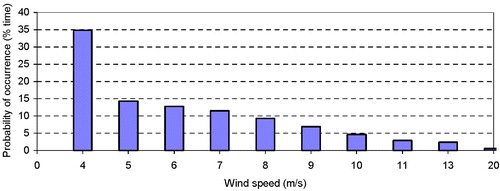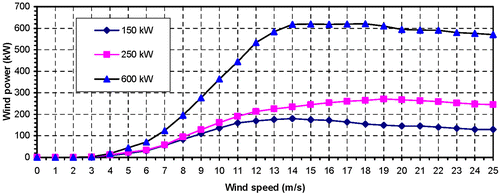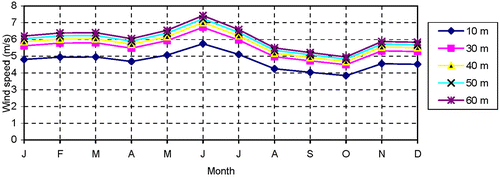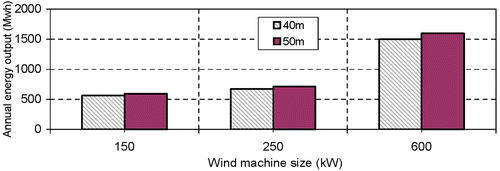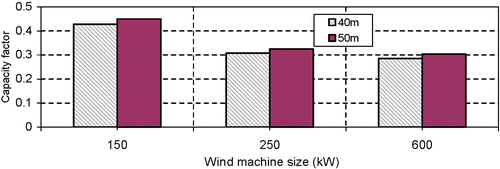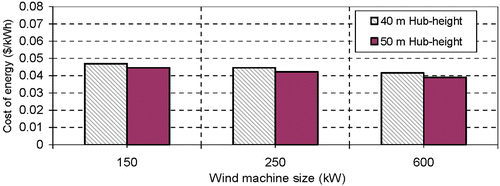Abstract
The recent increase in energy costs, driven by a surge in oil prices, has increased world‐wide efforts on the exploitation of renewable/wind energy resources for environment‐friendly sustainable development and to mitigate future energy challenges. Moreover, experience in the wind energy industry has reached high levels in the field of manufacturing and application. This inevitably increases the merits of wind energy exploitation. In order to exploit wind resources, through the establishment of wind power plants, specific attention must be focused on the characteristics of wind and wind machines. The literature indicates that wind‐energy resources are relatively better along coastlines. In the present study, long‐term hourly mean wind speed data for the period 1986–2003, recorded at Dhahran (Eastern Coastal region, Saudi Arabia), has been analysed to examine the wind characteristics including (but not limited to): yearly/monthly/diurnal variations of wind speed, frequency distribution of wind speed, impact of hub‐height/machine‐size on energy production, etc. Data have been checked/validated for completeness. Data analysis indicated that long‐term monthly average wind speeds ranged from 3.8 to 5.8 m/s.
Concurrently, the study determined monthly average daily energy generation from different sizes of commercial wind machines (150, 250, 600 kW, etc.) to assess the impact of wind machine size on energy yield. The study also estimated annual energy production (MWh/year) from wind farms of different capacities (3, 6, 12, 24 MW, etc.) by utilising different commercial wind energy conversion systems (WECS). It was observed that, for a given 6 MW wind farm size, a cluster of 150 kW wind machines (at 50 m hub‐height) yielded about 32% more energy when compared to a cluster of 600 kW wind machines. The study also estimated the cost of wind‐based electricity (COE, US$/kWh) by using different capacities of commercial WECS. It was found that the COE per kWh is 0.045 US$/kWh for 150 kW wind machine (at 50 m hub‐height) whereas COE was 0.039 US$/kWh for 600 kW wind machine (at 50 m hub‐height). The study also dealt with wind turbine characteristics (such as capacity factor and availability factor). These characteristics are important indicators of wind turbine performance evaluation.
1. Introduction
As oil prices continue to spiral upwards, the era of cheap fossil fuels is gradually diminishing. Also, in the light of the environmental benefits of renewable energy, big oil companies like Shell are investing millions of dollars on renewable solar/wind energy technology. Utilisation of energy from wind is gaining appreciable momentum and is being widely implemented to displace oil‐produced energy and to reduce the unprecedented and catastrophic damage that fossil fuel derived energy has on the environment. Modern thinking views wind derived energy as a shield against ever increasing oil‐power prices. The literature indicates that wind energy (being free, sustainable/end‐less, indigenous, site‐dependent, promising, non‐polluting, benign) is being rigorously pursued by a number of countries (with average wind speeds in the range of 4 to 10 m/s), in an effort to reduce their dependence on fossil‐based, non‐renewable fuels (Amr et al. Citation1990, Nayar et al. Citation1991, Evans Citation1992, Swisher and Gipe Citation1992, Bellarmine and Joe Citation1996, Daoo et al. Citation1998, Nfaoui et al. Citation1998, Rizk et al. Citation2001). Cumulative global wind energy capacity expanded to 59,094 MW in 2005. Currently, the cost of wind based electricity is in the range of 4 to 5 US cents/kWh. The technology of the wind machine has improved/progressed considerably (reducing the price of wind power) over the last five years. Wind is becoming one of the world's fastest growing energy sources. WECS in the range of 3.2 MW are commercially available. The rate of increase in installed capacity during the last 10 years is about 30% per annum (Global Wind Energy Market Report Citation2003). Typical wind power applications include lighting, electrical appliances, military installations, communication/gas stations, electricity for remote settlements (that are far from an existing utility grid), water pumping for irrigation or desalination, and cathodic protection of pipe lines, etc.
Stand‐alone WECS may not produce usable energy for a considerable portion of the time during the year primarily due to relatively high cut‐in wind speeds (speed at which WECS starts producing usable energy) which range from 3.5 to 4.5 m/s. In order to overcome this downtime, the use of hybrid wind‐diesel systems is recommended in the literature. Stand‐alone diesel generators, while being relatively inexpensive to purchase, are generally expensive to operate and maintain, especially at low load levels (Nayar et al. Citation1993). In general, the fluctuations of wind energy generation do not match the time distribution of the load demand on a continuous basis. Therefore, power generation systems dictate incorporation of short‐term battery storage to shrink the time‐distribution‐mismatch between the load and wind energy generation and to account for maintenance/outages of the systems (Traca et al. Citation1983, Seeling Citation1997). Wind‐driven power systems are expandable because, by using a modular concept, additional capacity may be added as the need arises. The initial capital cost of a wind power system is ∼1100 $/kW and that of a battery is ∼170 $/kWh (Bergey Citation1993). The prospects of derivation of power from hybrid wind/diesel/battery systems are proving to be promising world‐wide (Nayar et al. Citation1993, Cramer Citation1994, Beyer and Langer Citation1996, Bhatti et al. Citation1997, McGowan and Manwell Citation1998).
The Kingdom of Saudi Arabia's (KSA) total electricity generation has increased remarkably (from 1141 MW in 1975 to 19,351 MW in 1997; also the peak demand is expected to be 59,000 MW in 2020) during the last two decades (Ministry of Industry & Electricity Citation1997, Omar Citation2002). In particular, Dhahran's peak electricity demand has escalated from 7317 MW in year 1995 to 8332 MW in 2001 (Annual report 1999–Citation2000, Abdulrahman Citation2002). The above significant increases can be attributed to rapid growth in residential, commercial, and industrial sectors. The installed generating capacity of the power plants in the Kingdom reached more than 30,000 MW in 2003 (Annual report 2003–Citation2004). Since KSA is blessed with a reasonable wind regime, a proportion of its energy needs may be captured by exploiting its wind resources. The literature indicates that the introduction of a 1.5 MW WECS (capable of producing about 4 million kWh of energy per year) would eliminate 5.6 million tons of CO2 (Hansen Citation1998) (About wind energy, see http://www.wind.enron.com/windenergy.html). Another motive for introducing WECS is the possible stimulation of the local economy by making use of available local resources. More importantly, wind energy can contribute to the national energy mix and the Kingdom can comply with international directives to reduce greenhouse gases (Bellarmine and Joe Citation1996). Utilisation of renewable/wind energy would result in a substantial reduction of carbon dioxide emissions (thus preserving the environment). The Kingdom will be listed among those nations that are using renewable energy and following international obligations to reduce carbon dioxide emissions. In addition, employment opportunities are expected to increase with the deployment of renewable energy systems.
The research on feasibility of renewable energy systems at Dhahran (26° 32′ N, 50° 13′ E), KSA was the subject matter of earlier studies (Elhadidy and Shaahid Citation1998, Elhadidy and Shaahid Citation1999, Elhadidyv and Shaahid Citation2000). In order to exploit wind energy to establish wind power plants, attention must be focused on the quantitative assessment of available wind resources. In the present study, hourly mean wind‐speed data for the period 1986–2003 recorded at the meteorological and solar radiation station, Dhahran, KSA, was analysed to present the yearly/monthly/diurnal variations of mean wind speed, frequency distribution of wind speed (i.e. availability of wind in different wind speed bins), etc. In parallel, the study evaluated the impact of hub‐height (30, 40, 50, 60 m, etc.) on energy production. The study also determined monthly average daily energy generation/output from different sizes of commercial wind machines (150, 250, 600 kW, etc.) to assess the effect of wind machine size on energy yield (for a given wind farm size, for a given hub‐height). Emphasis was also placed on computation of the cost of energy per kWh by using wind machines of various capacities. Concurrently, the study also dealt with wind turbine characteristics (such as capacity factor, availability factor).
2. Site‐specific information
Climatic conditions determine the availability and magnitude of wind energy at a given site. Dhahran is located just north of the Tropic of Cancer on the eastern coastal plain of Saudi Arabia and is nearly 10 km inland from the Arabian Gulf Coast. Although it is in the vicinity of the coast, Dhahran is situated in a desert environment. Two distinct seasons are noticed in this region: a very hot season (May to October) and a cold season (November to April). Monthly mean temperatures reach close to 37°C for hot months and in cooler months the mean temperatures drop by about 20°C as compared to the hot months. The relative humidity exhibits a large diurnal cycle, in the order of 60%, throughout the year. Typical total annual precipitation is about 80 mm. The winds blow mainly from the 270 to 360° direction range (north to north‐westerly winds) for most of the time during the year (Shaahid and Elhadidy Citation1994).
3. Instrumentation
The meteorological and solar radiation station of the Center for Engineering Research of the Research Institute is located at Dhahran (from where the view of the horizon is unobstructed). The parameters measured at the station are reported in Elhadidy and Shaahid (Citation1994). The instruments meet the requirements for class 1 sensors according to the classifications of the World Meteorological Organisation (Guide to Meteorological Instrument and Observing Practices 1971–1972). The data are collected every minute and integrated over each hour. The wind speed measurements are made using a Texas cup anemometer. The station is continuously supervised (to clean the sensors, to minimise loss of data due to instrumental problems, to ascertain accuracy, etc.). The sensors are regularly calibrated against reference sensors maintained at the station. A detailed description of the equipment/station has been provided in Shaahid and Elhadidy (Citation1994).
4. Wind data analysis
The patterns of yearly and monthly mean wind speeds over Dhahran are highly variable. figure 1() shows yearly variation of wind speed. It appears that the variation follows a cycle. This supports the need for long‐term wind speed data for design purposes. The long‐term monthly average wind speeds for Dhahran (for the period 1986 to 2003) are presented in figure 1(). Wind speeds are generally higher in summer months (May to August) as compared to other months. This indicates that a WECS would produce appreciably more energy during summer months. This seasonal trend of wind speed matches with the higher electrical load requirements during the summer period in KSA. Long‐term monthly average wind speeds for Dhahran range from 3.8 to 5.8 m/s. The agreement between the wind energy production mode and the monthly load behaviour increases the merit for the establishment of wind farms in the KSA. The long‐term overall average wind speed has been found to be 4.7 m/s. The data also show that there is considerable variation of monthly average wind speed from one month to another. These variations show that the monthly energy output from WECS would be subjected to considerable differences. figure 1() displays the diurnal variation of wind speed. The diurnal variation provides information on the availability of wind during the entire day. The diurnal variation shows relatively higher winds between 900 and 1800 hours with lower values during the rest of the day. This diurnal behaviour of wind speed actually matches the general electricity demand and hence it would be useful to capture more power from the wind during day time. The frequency distribution of wind speed (i.e. availability of wind in different wind speed bins), is demonstrated in Figure which shows that wind speeds are less than 4 m/s for 35% of the time during the year (Elhadidy and Shaahid Citation1999). The cut‐in speed of most of the commercial wind machines (CWMs) is about 4 m/s. This implies that stand‐alone WECS installed at Dhahran will not produce energy for about 35% of the time during the year. In order to overcome this downtime, a diesel back‐up or a large energy storage system may be needed to meet the required load. The power curves of some of the CWMs are shown in Figure .
Figure 1 (a) Yearly variation of wind speed at Dhahran. (b) Monthly average wind speed at Dhahran (average of the period 1986–2003). (c) Diurnal variation of wind speed at Dhahran.
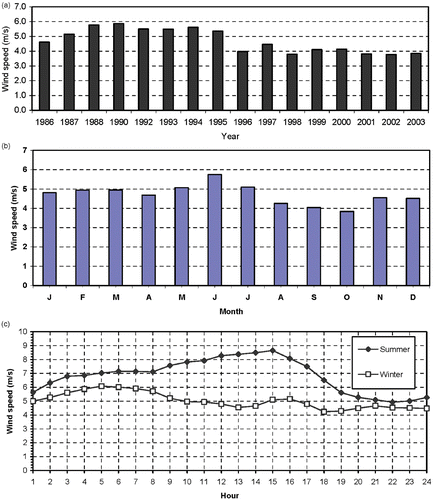
The wind energy calculations were made by matching the power‐wind speed characteristics of CWMs with the long term, hourly hub‐height wind speed data. The technical‐data for some of the NORDEX‐CWMs are furnished in Table . Despite maturity in the state‐of‐the‐art/technical‐know‐how, today's best wind machines can achieve an overall efficiency of about 35% (Elhadidy and Shaahid Citation1998). An earlier study on wind energy (Elhadidy and Shaahid Citation1999) suggests that in order to avoid the under‐sizing or over‐sizing of WECS or diesel systems, the data for the years 1987 to 1995 can be safely used for design purposes. However, in this study, the year 1992 was considered as a representative year for analysis.
Table 1. Power‐wind characteristics of some commercial wind machines and cost of energy ($/kWh).
5. Results and discussion
5.1 Impact of hub‐height on wind energy production
The wind data available at most of the meteorological stations world‐wide are measured at a height of 10 m. Therefore, wind speeds measured at anemometer heights are extrapolated to the hub‐height of the wind turbine. The hub‐height of a wind turbine has a pronounced impact on energy production. In order to study the impact of hub‐height, wind speed/energy calculations were made at 30, 40, 50, and 60 m above the ground level (wind is faster, less turbulent and yields more energy at heights of 30 m or more above the ground) (Abderrazzaq Citation2002) (Wind Energy, see http://www.eren.doe.gov/femp/techassist/wind_energy.html). These heights are equivalent to hub/tower heights of CWMs. Wind turbines are usually mounted on tall towers (30 to 70 m tall) to capture/harness more energy. The tower raises the wind turbine so that its blades safely clear the ground and so that it can reach stronger winds at higher elevations. The estimation of wind speed/energy at different heights has been carried out by using the 1/7th wind power law. The 1/7th power law is recognised as a handy tool to carry out vertical wind speed extrapolation to the desired hub height (Farrugia Citation2002). Figure presents long‐term, monthly average wind speeds at different heights above the ground. In passing from 10 to 50 m height, it was found that wind speed increases by about 26%. The hourly wind speeds are matched with the power curves of each CWM to estimate the annual electricity (wind‐based energy) it would produce. Wind energy calculations have been made for different NORDEX wind machines of various rated capacities and the results are presented in Table . The results exhibit that in passing from 30 to 40 m height, the energy production increases by 7%. Additionally, in passing from 30 to 50 m height, the energy production increases by about 12%.
Table 2. Yearly average daily energy generated from commercial wind machines (for the year 1992, at different hub heights).
5.2 Impact of wind machine size on energy production
The choice of wind machine must be compatible with the climatic characteristics of the site under consideration. Particular attention was focused on the impact of size of wind machine on wind farm from energy production point of view (for a given wind farm size, for a given hub height). Monthly average daily energy calculations were made for a 3 MW (for e.g.) wind farm consisting of 5, 12 and 20 machines of 600, 250 and 150 kW rated output (at a hub height of 50 m above the ground level) respectively and the results are summarised in Table . It was found that for a given 3 MW wind farm size (at 50 m hub height) a cluster of twenty 150 kW wind machines yields about 28% more energy when compared to a cluster of twelve 250 kW wind machines. Furthermore, for the same 3 MW wind farm size (at 50 m hub height), a cluster of twenty 150 kW wind machines yields about 33% more energy when compared to a cluster of five 600 kW wind machines. This analysis indicated that wind machines of smaller size produce more energy collectively in a given wind farm when compared with larger machines. This considerable increase in energy production could be attributed to an increase in the number of wind machines. The annual energy production from 3, 6, 9, 12, and 24 MW wind farms (by using clusters of various commercial WECS at different hub‐heights) is shown in Table . It is evident from this table that wind farms with clusters of smaller wind machines yield more energy as compared to wind farms with clusters of larger wind machines. For example, the annual energy production of a 6 MW wind farm with 150 kW machines (at 50 m hub‐height) is about 32% greater than the annual energy production of a 6 MW wind farm with 600 kW WECSs. It can also be seen from Table that the annual energy production of a 6 MW wind farm with 250 kW machines (at 50 m hub‐height) is about 7% greater than the annual energy production of a 6 MW wind farm with 600 kW WECSs.
Table 3. Monthly average daily wind energy (kWh) generated from 20, 12 and 5 wind turbines of rated capacities 150, 250, 600 kW respectively (for the year 1992 at Dhahran, at a hub height of 50 m).
Table 4. Yearly energy generated (MWh) from different wind farms formed by wind machines of various sizes (for a given year 1992, at different hub heights).
5.3 Wind turbine characteristics
To better understand the importance of wind turbine characteristics for a given generator, capacity factor and availability factor were investigated. These characteristics are important indicators for wind turbine performance evaluation (Tsang et al. Citation2003).
5.3.1 The capacity factor
The capacity factor is given as the ratio of the actual energy output to the theoretical maximum output, if the machine was running at its rated power during all the 8760 hours of the year. The annual energy yield is understood as the total number of kilowatt‐hours actually produced by a wind turbine installation or a wind farm in a year (at a given hub‐height). The capacity factor is an important indicator in measuring the productivity of a wind turbine. Although capacity factors may theoretically vary from 0 to 100%, in practice they usually range from 20 to 70%. The value of this factor is actually affected by the intermittent nature of the wind, the machine availability, and the turbine efficiency. The capacity factors are calculated using the following equation (http://www.windpower.org/en/tour/wres/annu.htm):
5.3.2 The availability factor
The availability factor is defined as a measurement of the operation percentage of a wind turbine. It refers to the percentage of time that a wind turbine is operating which depends on wind turbine characteristics and wind energy potential. In general, the availability factor increases with the decrease in the cut‐in wind speed of a wind turbine and with increase in the cut‐off wind speed. Most modern wind turbines have high values of the availability factor. The frequency distribution of wind speed (i.e. availability of wind in different wind speed bins), is demonstrated in Figure which shows that wind speeds are less than 4 m/s for 35% of time during the year (Elhadidy and Shaahid Citation1999). The cut‐in speed of most of the commercial wind machines (CWMs) is about 4 m/s. This indicates that stand‐alone WECS installed at Dhahran will not produce energy for about 35% of the time during the year. This implies that the availability factor is 65% (i.e. the power of the wind can be harnessed for 65% of the time).
5.4 Cost of wind‐based electricity ($/kWh)
The energy supply market is very competitive, led by utilities and fuel companies that meet nearly all our energy demands. Alternative energy sources, like wind power, provide new options but must be competitive with conventional energy sources and be economical. A wind energy system requires a large initial capital investment, but over its lifetime it will provide years of energy with no fuel cost while the costs of other sources of energy may escalate.
The cost of a wind system has two components: initial installation costs and operational maintenance (O&M) cost. The installation cost includes the purchase price of the complete system (including tower, wiring, utility interconnection or battery storage equipment, power conditioning unit, etc.) plus delivery and installation charges, professional fees and sales tax. The total installation cost can be expressed as a function of the wind system's rated electrical capacity. A grid connected residential‐scale system (1–10 kW) generally costs between $2400 and $3000 per installed kilowatt. That is $24,000–$30,000 for a 10 kW system. A medium‐scale, commercial system (10–100 kW) is more cost‐effective, costing $1500 and $2500 per kW. Large‐scale systems of greater than 100 kW cost in the range of $1000 to $2000 per kW with the lowest cost achieved when multiple units are installed at one location. In general, cost rates decrease as machine capacity increases. The other cost component, i.e. O&M cost, is incurred over the lifetime of the wind system. Operating costs include maintenance and service, insurance and any applicable taxes. A rule of thumb, estimate for annual operating expenses is about 3% of the initial system cost (Wind Energy Manual, see http://www.energy.iastate.edu/renewable/wind/wem/wem‐01_print.html).
Cost of energy (COE) is computed by using the following equation:
5.5 Case‐study: hybrid wind/diesel/battery system for residential loads
This section provides an indication of the number of 150 kW wind machines that might be required to meet residential loads. Load is an important/governing element of any power generating system. As a case study and as a representation of residential buildings, the measured annual average electrical energy consumption (based on 5 years of data) of one hundred typical centrally air‐conditioned family houses (floor area of each house = 169.98 m2), in Dhahran, has been considered as yearly load (3512 MWh) in the present analysis (Internal report Citation1992). This load could also be representative of a group of remotely located (off‐grid) residential buildings which do not have access to the utility grid (even today, there are many communities living/dwelling in small pockets in remote locations of Saudi Arabia). The projected monthly average daily load profile is shown in Figure . As depicted in Figure , the load appears to peak during June to September. The peak requirements of the load dictate the system size.
Figure 8 Comparison between energy generated by wind[WECS (150 kW)] systems using 1992 data with 3 days of battery storage at 30 m hub height (at Dhahran).
![Figure 8 Comparison between energy generated by wind[WECS (150 kW)] systems using 1992 data with 3 days of battery storage at 30 m hub height (at Dhahran).](/cms/asset/c019f1f0-94da-445a-80c3-d9c4d21972a8/tsue_a_366067_o_f0008g.gif)
The hybrid systems simulated consist of different combinations of 150 kW WECS, supplemented with a battery storage system and diesel back‐up. The simulation/analysis explores a suitable mix of wind farm capacity and battery storage to match the load while minimising the operation of the diesel generator. In the light of economic considerations and for optimum use of battery‐storage/diesel, battery storage is assumed to be equivalent to three days of maximum monthly average daily demand (Elhadidy and Shaahid Citation1999).
For a given battery storage (equivalent to about 3 days of maximum monthly average daily demand), the variation of monthly average daily wind energy from different numbers of 150 kW machines, for the chosen year of 1992, is presented in Figure . It is clear from Figure that a combination of three 150 kW machines, does not satisfy the load requirements for all months of the year. This indicates that a significant amount of energy needs to be supplied from the diesel generator to meet the load. Extensive use of the diesel system may result in frequent start/stop cycles of the diesel generator (frequent start‐ups/stops promote wear). Moreover, the focal point of the renewable energy studies is to minimise the contribution of diesel. Therefore, in‐order to minimise the contribution of diesel, simulations were made by increasing the number of wind machines. It is obvious from Figure that, as penetration of WECS increases, operational months/hours of diesel system operation (to meet the load) decrease. For an installation of seven 150 kW WECS and battery storage (equivalent to about 3 days of maximum monthly average daily demand), the load requirement is satisfied for about 8 to 9 months. For this scenario, the diesel backup system has to be operated during the period from August to October in order to match the load distribution.
6. Conclusions and recommendations
The present study has shown that the long‐term monthly average wind speeds for Dhahran range from 3.8 to 5.8 m/s. In view of this reasonable wind regime, an appreciable fraction of this region's energy needs may be harnessed from wind energy. The effect of hub‐height on wind energy generation in a given wind farm have been examined. The analysis highlighted that hub‐height plays an important role in energy production. It was found that, in passing from 30 to 50 m height, the monthly average daily energy production increased by 12%. The impact of wind machine size on wind energy generation in a given wind farm/park was also examined. It was found that for a given 12 MW wind farm size (at 50 m hub‐height) a cluster of 150 kW wind machines yielded about 32% more energy when compared to a cluster of 600 kW wind machines. An attempt was also made to determine the cost of energy (COE, US$/kWh). The COE was found to be 0.04462, 0.04215 and 0.039076 US $/kWh for 150, 250, 600 kW wind machines (at 50 m hub‐height) respectively.
The study also addressed capacity factor and availability factor. The capacity factors were found to vary between 28 and 45% (depending on size of machine and hub‐height). It was observed that the capacity factor of smaller size wind machines was higher when compared to the capacity factor of larger WECS. The availability factor of wind turbines installed at Dhahran was found to be 65% (this means a WECS installed at Dhahran would produce energy for about 65% of the time during the year).
The study also highlighted the importance of hybrid wind‐diesel systems. It was found that, as penetration of WECS increased, operational months/hours of diesel system (to meet the load) decreased. Future work on this subject will include: economic analysis (cost of energy, US$/kWh), carbon emissions, excess energy generation, un‐met load, etc. of diesel‐only/wind‐only systems and hybrid wind‐diesel systems. Results of the future/proposed study will compare the hybrid systems (and grid connected systems) with wind‐only/diesel‐only systems with respect to carbon emissions, cost of energy, excess energy generation, etc. Future work will also include comparison with other/recent works conducted in the region. The observations of the present base‐line study provide a basis/platform/reference for establishment of wind farms and for future studies.
Wind resource assessment of different regions of the Kingdom of Saudi Arabia need to be carried out for large scale exploitation/utilisation of wind energy and for a sustainable future. This effort will eventually reduce dependence on fossil fuel. More importantly, an appreciable portion of the energy requirements of the Kingdom can be met by wind energy. Over dependence on depleting/finite fossil fuels is alarming. Hence investment on renewable/wind energy is imperative to promote utilisation of wind energy and to mitigate a possible future energy crisis. This is also a step towards clean energy.
Acknowledgement
This work is part of the KFUPM/RI project no. 12011 supported by the Research Institute of the King Fahd University of Petroleum and Minerals.
References
- Abderrazzaq , M. H. 2002 . Tower height assessment for optimal wind energy exploitation. . International Journal of Renewable Energy Engineering , 4 (1) : 161 – 175 .
- Abdulrahman , S. H. 2002 . “ Charging experiments on a cool thermal store filled with balls containing water. ” . In Proceedings of the first symposium on energy conservation & management in buildings , 103 – 112 . Riyadh : Saudi Consolidated Co. . 5–6 February 2002, Dhahran
- Amr , M. , Petersen , H. and Habali , S. M. 1990 . Assessment of windfarm economics in relation to site wind resources applied to sites in Jordan. . Solar Energy , 45 (3) : 167 – 175 .
- Annual report . 1999–2000 . “ Saudi consolidated electric company Eastern Province/Saudi Arabia. ” . 25
- Annual report . 2003–2004 . “ Saudi Electricity Company, Riyadh, Saudi Arabia ” .
- Bellarmine , T. G. and Joe , U. 1996 . Wind energy for the 1990s and beyond. . Energy Conversion & Management , 37 (12) : 1741 – 1752 .
- Bergey , M. 1993 . “ Village electrification: hybrid systems. ” . In Wind energy applications and training symposium , 44 Riyadh : Saudi Consolidated Co. . 7 July 1993, Amarillo, TX
- Beyer , G. H. and Langer , C. A. 1996 . Method for the identification of configurations of pv/wind hybrid systems for the reliable supply of small loads. . Solar Energy , 57 (5) : 381 – 391 .
- Bhatti , T. S. , Al‐Ademi , A. A. F. and Bansal , N. K. 1997 . Load frequency control of isolated wind diesel hybrid power systems. . Energy Conversion & Management , June : 829 – 837 .
- Cramer , D. G. 1994 . Technology transfer allows China to build exotic power systems. . Power Engineering , February : 33 – 35 .
- Daoo , V. J. 1998 . Assessment of wind energy potential of Trombay, Mumbai, India. . Energy Conversion & Management , 39 (13) : 1351 – 1356 .
- Elhadidy , M. A. and Shaahid , S. M. 1994 . Effect of Kuwait's oil‐fire smoke cloud on global horizontal irradiance at Dhahran, Saudi Arabia. . Solar Energy , 52 (5) : 439 – 446 .
- Elhadidy , M. A. and Shaahid , S. M. 1998 . Feasibility of hybrid (wind+solar) power systems for Dhahran, Saudi Arabia. . World Renewable Energy Congress V , 20–25 September 1998, Florence
- Elhadidy , M. A. and Shaahid , S. M. 1999 . Optimal sizing of battery storage for hybrid (wind+diesel) power systems. . International Journal of Renewable Energy , 18 (1) : 77 – 86 .
- Elhadidy , M. A. and Shaahid , S. M. 2000 . Parametric study of hybrid (wind+solar+diesel) power generating systems. . International Journal of Renewable Energy , 21 : 129 – 139 .
- Evans , L. C. 1992 . Wind Energy in Europe. . Solar Today , May/June : 32 – 34 .
- Farrugia , R. N. 2002 . The wind shear exponent in a mediterranean island climate. . Renewable Energy , 28 (4) : 647 – 653 .
- Global Wind Energy Market Report . 2003 . “ American Wind Energy Association. ” . Available from: http://www.awea.org [Accessed 18 December 2008]
- Guide to Meteorological Instrument and Observing Practices . 1971–1972 . “ Report WMO, No.8. TP3, Geneva, Switzerland ” .
- Hansen , U. 1998 . Technological options for power generation. . The Energy Journal , 19 (2) : 63 – 87 .
- Internal report . 1992 . “ Analysis of electric energy consumption in residential buildings, P/N#12031, Research Institute, KFUPM, Dhahran, Saudi Arabia ” .
- McGowan , J. G. and Manwell , J. F. 1998 . Wind/diesel energy systems: review of design options and recent developments. . Solar Energy , 41 (6) : 561 – 575 .
- Ministry of Industry & Electricity . 1997 . “ Electrical growth and development in the Kingdom of Saudi Arabia 1997. ” . In Electrical Affairs Agency. Riyadh, Kingdom of Saudi Arabia
- Nayar , C. V. 1991 . Design considerations for appropriate wind energy systems in developing countries. . Renewable Energy , 1 (5/6) : 713 – 722 .
- Nayar , C. V. 1993 . Novel wind/diesel/battery hybrid energy system. . Solar Energy , 51 (1) : 65 – 78 .
- Nfaoui , H. , Buret , J. and Sayigh , A. A. A. 1998 . Wind characteristics and wind energy potential in Morocco. . Solar Energy , 63 (1) : 51 – 60 .
- Omar , B. 2002 . “ Future potential for energy services in Saudi Arabia. ” . In Proceedings of the first symposium on energy conservation & management in buildings , 175 – 183 . Texas : Bergey Wind Power . 5–6 February 2002, Dhahran
- Rizk , J. , Nagrial , M. H. and Mitchell , K. 2001 . Wind energy in Australia. . Proceedings of abstracts, 7th Arab International Solar Energy Conference , : 235 – 236 . 19–22 February 2001, Sharjah
- Seeling , G. C. H. 1997 . A combined optimisation concept for the design and operation strategy of hybrid‐pv energy systems. . Solar Energy , 61 (2) : 77 – 87 .
- Shaahid , S. M. and Elhadidy , M. A. 1994 . IBM pc based data acquisition system for solar radiation station. . Proceeding of 40th international instrumentation symposium , 1–5 May 1994, Baltimore, MA, ISA 40
- Swisher , R. and Gipe , P. 1992 . U.S. Windfarms: an expanding market. . Solar Today , November/December : 17 – 19 .
- Traca , A. 1983 . Source reliability in a combined wind‐solar‐hydro system. . IEEE Transactions on Power Apparatus and Systems , : 1515 – 1520 . PAS‐102 (6), June
- Tsang , J. C. 2003 . Assessment of wind characteristics and wind turbine charactetistics in Taiwan. . Renewable Energy , 28 : 851 – 871 .
